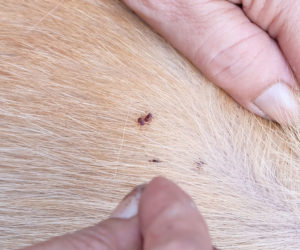One way to know if a dog has fleas is by observing excessive scratching and biting. Another sign is the presence of small black specks or white eggs in the fur.
Dogs may also develop skin irritations or hair loss due to flea infestations, which can be further indicators of the problem. Additionally, if you notice flea dirt or actual fleas on your dog, it’s a clear indication of an infestation.
It’s important to regularly check your dog for fleas, especially during warmer months, and to consult a veterinarian for proper treatment if you suspect an infestation. By being vigilant and observant, you can keep your furry friend flea-free and healthy.
Understanding Fleas And Their Impact
Fleas are small, wingless insects that survive by feeding on the blood of animals. These parasites can cause a range of health issues for dogs, including itching, redness, and skin infections. Additionally, fleas can transmit diseases and parasites. Identifying fleas on your dog can be challenging as they are fast-moving and often hide within the fur. Some common signs of fleas include excessive scratching, biting, or licking, and tiny black specks on the skin, known as flea dirt. To determine if your dog has fleas, use a fine-toothed comb to search for live fleas and their droppings. It is crucial to promptly address a flea infestation to prevent discomfort and health problems for your beloved pet.
Signs And Symptoms Of Flea Infestation
Scratching and Itching: Dogs with fleas often exhibit excessive scratching, biting, or licking, especially around the tail or legs.
Redness and Irritation in Affected Areas: Flea bites can cause red, inflamed skin, particularly in areas with less hair.
Visible Fleas or Flea Dirt on Your Dog’s Coat: Flea dirt, resembling dark specks, may be found in the fur, and occasionally, the parasites themselves may be seen.
Diagnosis And Treatment Options
When diagnosing a potential flea infestation, it is essential to look for common signs such as excessive scratching, red bumps, and flea dirt in the hair. Seeking professional veterinary care and guidance can be crucial in determining the presence of fleas and developing an appropriate treatment plan. Effective treatment options may include oral or topical medications, flea collars, and environmental control measures. It is important to consult with a veterinarian to ensure the safety and suitability of the selected treatment approach for the affected dog.

Credit: www.hartz.com
Frequently Asked Questions For How Do You Know If A Dog Has Fleas
How Do I Check My Dog For Fleas?
To check your dog for fleas, part its fur and look for small, dark insects or tiny red dots. Comb through its hair with a flea comb to catch any fleas. If you find them, consult a vet for treatment options.
Regular grooming and using preventive products can help.
What Are Symptoms Of Fleas On Dogs?
Symptoms of fleas on dogs include itching, scratching, redness, and skin irritation. You may also notice flea dirt in the fur, hair loss, and hot spots. Keep an eye out for excessive licking or biting. If you suspect fleas, consult your veterinarian for treatment.
Can My Dog Have Fleas If I Don’t See Them?
Yes, your dog can have fleas without you seeing them. Fleas are good at hiding and can multiply quickly. Regular checks for fleas are important.
Would You Notice If Your Dog Has Fleas?
Yes, you can notice if your dog has fleas by looking for excessive scratching, red irritated skin, and tiny black specks in their fur. Regular grooming and flea prevention can help keep your dog free from fleas.
Conclusion
Detecting fleas on your dog is crucial for their well-being. Regular grooming and preventive measures like flea treatments are key to keeping your furry friend happy and healthy. If you suspect fleas, consult your vet and follow their advice to eliminate the pesky pests and ensure your dog’s comfort.


